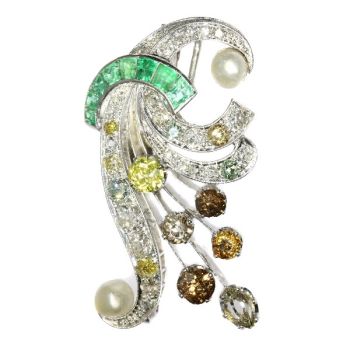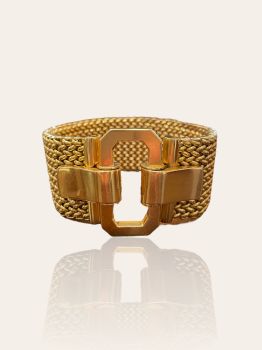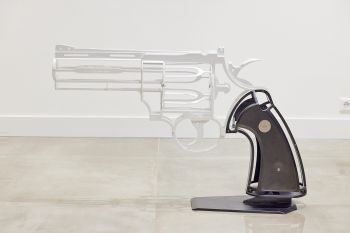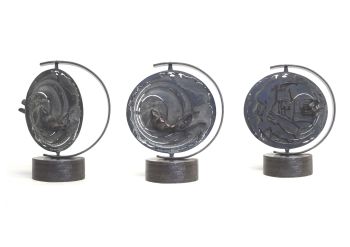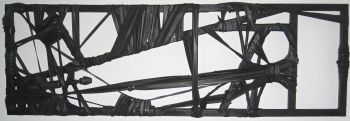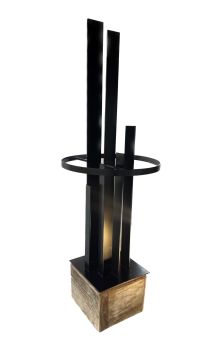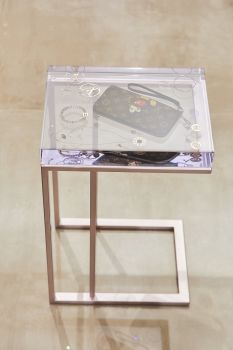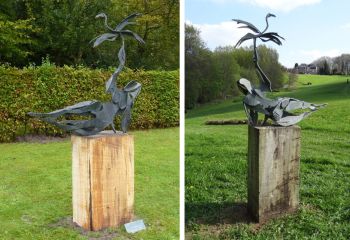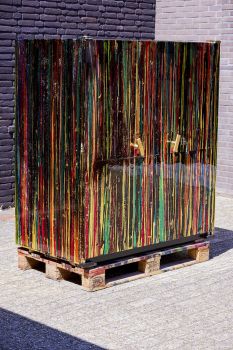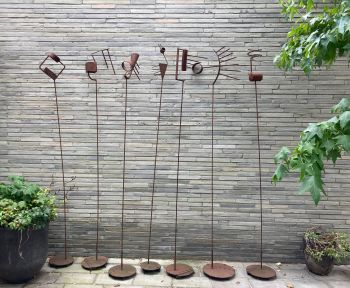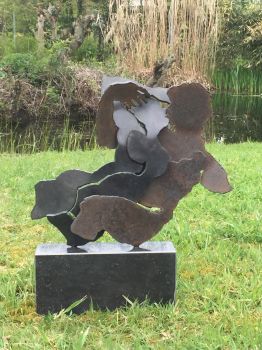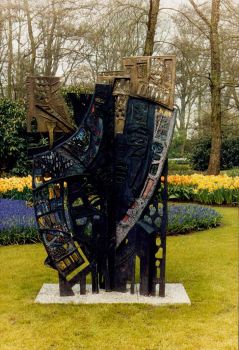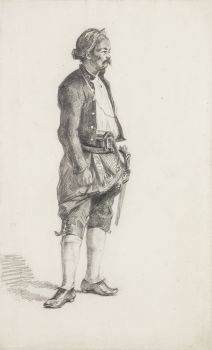A superb inlaid walrus ivory and blue glass Ottoman knife 1700
Artiste Inconnu
OSVerreAcierIvoireMétal
Prix sur demande
Zebregs & Röell - Fine Art - Antiques
- Sur l'oeuvre d'artA superb inlaid walrus ivory and blue glass Ottoman knife
Ottoman Empire, Turkey, probably Constantinople (Istanbul), late 17th/early 18th-century
The hilt is formed of a faceted blue glass, while the blade of steel exhibits faux-watering and is inset with beads of coral at three equidistant slots just beneath the spine. The surface of the blade has also been etched over the greater part of its length with an inscription on one face with a part of the Nada ‘Ali quatrain and on the other with “… Muluk (?) sultan malik tahir (?)” (“… of Kings (?), Sultan Malik Tahir (?)”) among vine tendrils that exhibit remnants of the original gilding. Gilt stellar motifs also line the spine of the blade.
The scabbard is inset with a generous array of khatamkari roundels depicting celestial motifs with gems, mother-of-pearl and various metals. Of particular splendour are the ebony tesserae, which are overlaid with pointed stars in gold, some of the larger examples decorated at their centres with an inset turquoise or gold concentric circles. The craftsman has expended great efforts to ensure almost no space is left unfilled, inviting the spectator to inspect the scabbard’s surface as one might survey a busy night-sky. It is interesting to note, too, that the central roundel of the front face is decorated on a shimmering white ground in mother-of-pearl, whilst that on the reverse is black (ebony), as if the front and reverse of the scabbard signified the day and night skies respectively. The scabbard’s gilt-silver collar and chape are punched and chased to depict stylised leaves and roundels in imitation of the scabbard’s central surface, and are further inset with small turquoises as well as coloured gem stones, the chape terminating in a cross-hatched acorn finial.
L. 19.7 cm
Provenance:
With Runjeet Singh, London
This remarkable knife brilliantly exemplifies the artistry so often applied to exceptional pieces of arms and armour, its scabbard proficiently decorated throughout with roundels in a dazzling array of colours and patterns.
Remarkably, the side of the scabbard shows a zig-zag motif, to some immediately recognizable from Japanese Namban export lacquer ordered by the Portuguese. This lacquerware was not intended for the Portuguese market only and was often given as diplomatic gifts to different courts – also to the Ottoman court. The resemblance is so uncanny that it is tempting to suggest that the craftsman took inspiration from such a piece. After all, it is widely known that at the Ottoman court, too, Chinoiserie was in fashion.
A very comparable knife and scabbard can be found in the Schatzkammer of the Bavarian Palace in Munich (inv.no. 1235 or 1819/20). It probably entered the collection through the Pfälzer Wittelsbacher line, who in the 16th and 17th century were known to collect Ottoman artefacts as Turquerie, also known as Turkomania, was in vogue.
A miniature sword in the Walters Art Museum (access.no. 51.79) exhibits a similar sequence of insets along the back-edge of its blade. - Sur l'artiste
Il peut arriver qu'un artiste ou un créateur soit inconnu.
Certaines œuvres ne doivent pas être déterminées par qui elles sont faites ou elles sont faites par (un groupe d') artisans. Les exemples sont des statues de l'Antiquité, des meubles, des miroirs ou des signatures qui ne sont pas claires ou lisibles, mais aussi certaines œuvres ne sont pas signées du tout.
Vous pouvez également trouver la description suivante :
•"Attribué à …." A leur avis probablement une oeuvre de l'artiste, au moins en partie
•« Atelier de …. ou « Atelier de » À leur avis, une œuvre exécutée dans l'atelier ou l'atelier de l'artiste, éventuellement sous sa direction
•« Cercle de… ». A leur avis une oeuvre de la période de l'artiste témoignant de son influence, étroitement associée à l'artiste mais pas forcément son élève
•« Style de … ». ou "Suiveur de ...." Selon eux, une œuvre exécutée dans le style de l'artiste mais pas nécessairement par un élève ; peut être contemporain ou presque contemporain
•« Manière de… ». A leur avis une oeuvre dans le style de l'artiste mais d'une date plus tardive
•"Après …." A leur avis une copie (quelle qu'en soit la date) d'une oeuvre de l'artiste
•« Signé… », « Daté… ». ou « Inscrit » À leur avis, l'œuvre a été signée/datée/inscrite par l'artiste. L'ajout d'un point d'interrogation indique un élément de doute
• "Avec signature ….", "Avec date ….", "Avec inscription …." ou "Porte signature/date/inscription" à leur avis la signature/date/inscription a été ajoutée par quelqu'un d'autre que l'artiste
Êtes-vous intéressé par l'achat de cette oeuvre?
Artwork details
Related artworks
Artiste Inconnu
Ancienne icône en bois russe: Archange Gabrielearly 17th
Prix sur demandeKunsthandel H.W.C. Dullaert Icons
1 - 4 / 12Artiste Inconnu
UNE COLLECTION DE QUATRE BOÎTES À BIBLE EN IVOIRE SRI LANKAN18th century
Prix sur demandeZebregs & Röell - Fine Art - Antiques
Artiste Inconnu
UN MODÈLE JAPONAIS D'UN NORIMONO, UN PALANQUIN1650 - 1700
Prix sur demandeZebregs & Röell - Fine Art - Antiques
Artiste Inconnu
The Stamford Raffles Secretaires.1800 - 1813
Prix sur demandeZebregs & Röell - Fine Art - Antiques
Artiste Inconnu
UN FILET D'IVOIRE D'UN DUTCHMAN TENANT UN COCKEREL18th century
Prix sur demandeZebregs & Röell - Fine Art - Antiques
Artiste Inconnu
UN RARE GRAND TÉLESCOPE EN CUIR LAQUÉ JAPONAIS1750 - 1800
Prix sur demandeZebregs & Röell - Fine Art - Antiques
1 - 4 / 24Artiste Inconnu
UNE COLLECTION DE QUATRE BOÎTES À BIBLE EN IVOIRE SRI LANKAN18th century
Prix sur demandeZebregs & Röell - Fine Art - Antiques
1 - 4 / 24Artiste Inconnu
Deux portraits d'étude du Mas Marco Kartodikromo1900 - 1950
Prix sur demandeZebregs & Röell - Fine Art - Antiques
Artiste Inconnu
The Stamford Raffles Secretaires.1800 - 1813
Prix sur demandeZebregs & Röell - Fine Art - Antiques
Artiste Inconnu
The bell of the VOC fortress in Jaffna, Sri Lanka1747
Prix sur demandeZebregs & Röell - Fine Art - Antiques
 Sélectionné par
Sélectionné parDanny Bree
Artiste Inconnu
A rare Japanese export lacquer medical instrument box1650 - 1700
Prix sur demandeZebregs & Röell - Fine Art - Antiques
1 - 4 / 12











